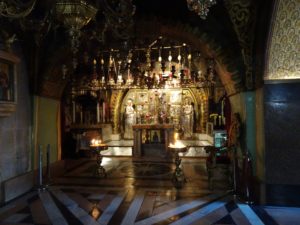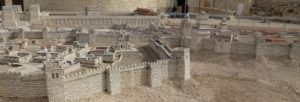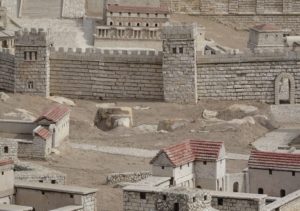WHAT REALLY HAPPENED IN HOLY WEEK? Part 6
THURSDAY NIGHT AND FRIDAY
Wealthy quarter of Jerusalem
The Jewish trial
It must have been about midnight when the Sanhedrin started their investigation of
Jesus. Mark assumes it was a formal trial, but that would not have been legal at night. They had to act fast. If they delayed till morning, 100,000 Galilean pilgrims could be on the march. Andy they were not completely sure whether with Jesus they might have bitten off more than they could chew. They knew that “he saved other people.” They shouted that when he was on the cross. Did he have a power they did not know about?
Caiaphas may have told his colleagues the trial was a preliminary investigation before handing the whole matter over to Pilate, who I guess had already been primed. They could have convened the Sanhedrin fast, because all the members were in Jerusalem for Passover. They did rustle up some witnesses who claimed that Jesus said he would destroy and rebuild the temple in three days. But they kept contradicting each other, so that was useless. John’s gospel records Jesus actual words: “Destroy this temple and I will raise it in three days”. (John 2.19-21) John explains that he was talking about his own body.
The whole trial looked like unravelling, so Caiaphas took a last gamble
“Are you the Messiah, the son of the Blessed One?”
To his amazement it worked! Jesus replied, using the name of God in Exodus 3.
“I AM. And you will see the Son of Man sitting at the right hand of the Mighty One and coming with the clouds of heaven.”
Caiaphas made a great show of being shocked, tearing his robes etc, and proclaimed it as blasphemy. The whole council agreed, and they left him to the tender mercies of Caiaphas’ servant, spitting, hitting and presumably putting him in the high priest’s lock-up until morning.
Meanwhile Peter had followed the arresting party right into the courtyard of the high priest’s mansion. It was a cold night, so he stood by the fire with the other servants. When a maid asked if he had been with Jesus, he instinctively said “No.” When others repeated the question, noting he had a Galilean accent, his denials became more and more emphatic – until the second cock crow, when he broke down and fled.
The Trial before Pilate
Just after dawn they handed Jesus over to the Roman governor, thinking that from now it would all be plain sailing. It was, until Pilate actually met Jesus.
Pilate was well aware of Jesus. He would have had daily reports from the Antonia fortress of goings-on in the temple. When Jesus cleared the traders out of the Court of the Gentiles, it must have crossed his mind to send in some legionaries to restore order. But the last time he had tried that it ended in a general massacre. And there was no way that the Sanhedrin could actually ask Gentile soldiers to come into the sacred precincts. Then things quieted down, and he reckoned that it would all blow over after Passover. Caiaphas’ urgent visit on Thursday night, (my supposition), changed everything.
Caiaphas had to persuade Pilate that Jesus was dangerous. ‘He might not be a Zealot revolutionary as such, but he certainly gives aid and spiritual comfort to the revolutionaries. After all, he comes from Galilee.’ Pilate would have regarded him similarly to how Israel would regard an Imam who knew members of Hamas. Pilate understood the need for speed and was ready to accommodate by meeting the prisoner at first light.
Mark gives us no details about Pilate’s meeting with Jesus, except that he was silent in the face of all the priests’ accusations. But it soon became clear to Pilate that here was no fanatical, revolutionary preacher. In other words, it was an internal Jewish affair and Caiaphas wanted him to do the Sanhedrin’s dirty work for him. He did not like Jews in general, and he certainly did not like being pushed around. However, he had to work with Caiaphas on a day-to-day basis, so he thought of a way around. Ask the crowd to decide who should die today: Jesus of Nazareth or Barabbas, a nationalist rebel. But he had reckoned without the persuasive power of the priests and elders. The crowd that gathered were Jerusalemites, who were not on Jesus’ side. Why should a Galilean come into their city and tell them what to do? And for Pilate to call this so-called prophet “the King of the Jews” was pretty insulting anyway, a bit like calling Bobby Sands the President of Ireland. So they shouted for Barabbas, and Pilate handed Jesus over to be crucified. After all, he had done his (rather limited) best.
The soldiers then had their bit of fun with this Jewish prophet-type. “Hail, King of the Jews!” they laughed, making a crown out of thorns. Then they led him out to crucify him.
The rock of Golgotha, Israel Museum
The Crucifixion
Jesus started off carrying the cross-beam which was going to be nailed to the permanent upright of the cross. According to John, Pilate had had Jesus scourged as a lesser punishment, but it meant he was too weak to carry the cross-beam. So the soldiers picked someone out of the crowd at random, Simon, a pilgrim from North Africa, to
carry it. Later his two sons, Alexander and Rufus would be well known members of the church in Rome.
They came to the rocky outcrop called Golgotha, or place of the Skull. They offered him wine with myrrh to deaden the pain, but Jesus did not take it. About 9 o’clock the soldiers nailed his wrists and ankles to the cross and lifted him up to suffer the long-drawn out agony of death by crucifixion.
“Can anyone be found who would prefer wasting away in pain dying limb by limb, rather than expiring once for all? Can any man be found willing to be fastened to the accursed tree, long sickly, already deformed, swelling with ugly weals on shoulders and chest and drawing the breath of life amid long-drawn-out agony? He would have many excuses for dying even before mounting the cross.” Seneca, a contemporary of Jesus.
Now Jesus was helpless, everyone hurled insults at him: passers-by, the chief priests, the two robbers crucified with him.
About midday the whole sky went dark and stayed that way. What happened? We don’t know. After three more hours of agony Jesus cried out in Hebrew the first verse of Psalm 22: “My God, my God, why have you forsaken me?” Some of those standing by (soldiers? passers-by?) thought that he was calling out for Elijah and they thought the prophet Elijah might suddenly appear and rescue him. They clearly thought this was no ordinary man. Jesus gave a loud cry and died.
All the gospels say that the thick curtain which hung between the Holy Place and the Holy of Holies, tore in two from top to bottom. The centurion in charge of the execution said, “Truly, this man was a son of God.”
A group of women followers of Jesus had stood there all the time, watching from a distance.
Not all members of the Sanhedrin were enemies of Jesus. One of them, Joseph of
Arimathea, had been a secret follower. Now he came into the open. He went to Pilate and asked for the body to give it a decent burial. Pilate was surprised he had died in a relatively short time, he checked with the centurion, and gave Joseph permission to place Jesus’ body in a nearby rock-tomb. Sadly, that was that. Calvary (Golgotha) Chapel Church of the Holy Sepulchre Under the altar is bare rock, with a hole for the cross upright
Calvary (Golgotha) Chapel Church of the Holy Sepulchre Under the altar is bare rock, with a hole for the cross upright


